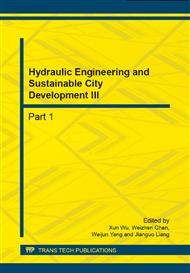p.232
p.236
p.241
p.246
p.251
p.255
p.261
p.267
p.271
Cognitive Calculation on Water Flow of Dongbei Waterway in Middle Reaches of Yangtze River
Abstract:
Dongbei waterway in the lower reach of Yangtze River includes three waterway: Hukou waterway, Heng waterway and Zhi waterway. The evolvement trend based on the measured data show that the right branch of Xiasanhaozhou is developed and the shallow shoal at the head of Xiasanhaozhou is scoured along with the right branch be rushed and ratio of diversion flow increase which have negative effect on transition shoals. In order to analysis the effect of evolvement trend on the channel conditions of transition shoals, this paper adopt cognitive calculation on water flow of Dongbei waterway using mathematic model. The results show that, the development of right branch of Xiasanhaozhou and the shallow shoal cutting at the head of Xiasanhaozhou decrease velocity of transition sections, decrease the diversion flow of the left branch of Xiasanhaozhou, and increase the diversion flow of the head of Xiasanhaozhou which have negative effect on transition shoals.
Info:
Periodical:
Pages:
251-254
Citation:
Online since:
September 2014
Authors:
Price:
Сopyright:
© 2014 Trans Tech Publications Ltd. All Rights Reserved
Share:
Citation:


